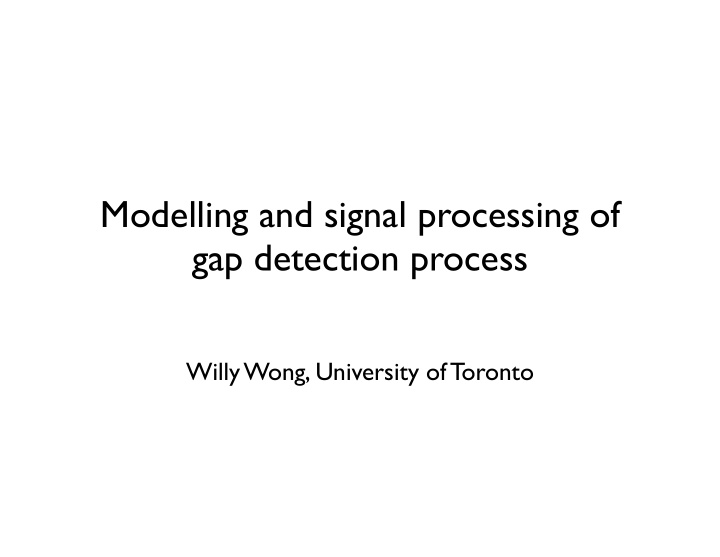



Modelling and signal processing of gap detection process Willy Wong, University of Toronto
Acknowledgements • Speech ABR Hilmi Dajani (assoc prof, U of Ottawa) • Method of significance Dr. Jie Cui (Barrow Neurological Institute) • Neural modelling Ewen Macdonald (assoc prof, TU Denmark) Sheena Luu
Gap detection stimulus f1 f2 t envelope “seen” by ear
Gap in speech perception Gaps in speech signals can cue phonetically important distinctions; for example, a gap is one cue to the presence of the stop consonant phoneme /p/ in the word “spoon,” in contrast to the word “soon” in which there is no gap. Pichora-Fuller et al (2006)
Single-channel model • Forrest et al (1991) Model of single-channel gap detection towards central sound regions BM IHC AN
Model response sound BM IHC AN
Across channels Formby et al (1998) Across-channel gap detection Small frequency : single-channel detection Big frequency : between-channel detection However, comprehensive model is missing
Electrophysiological approaches • e.g. Shinohara et al (1995) • correlation of ABR wave V to gap threshold • EP threshold < PP threshold We will be using an EP approach
Motivation • Electrophysiology is informative but challenging to interpret/analyze • Comprehensive model still missing • Hopefully there is a role for me here!
Outline • Time-frequency analysis • Blind statistical technique • Theory and modelling
Time-frequency analysis
Frequency analysis and stationary signals time domain frequency domain
Non-stationary signals Plotting spectral distribution over time is call a spectrogram General area is called time-frequency analysis
Time-frequency analysis can applied to a variety of signals
Speech spectrogram e.g. Winckel, Music, Sound and Sensation
Importance for formant analysis e.g. for vowels
TF also good for EP data! e.g. Farzan et al 2010
We did a relevant project involving time- frequency analysis of speech & ABR
Auditory brainstem response “click”
Periphery Brain
This is all fine if we are interested in “clicks”. But what about real signals like speech?
Clinical audiometry normal + = click abnormal
Complex signal ABR + = ABR e.g. speech TF ? normal abnormal
EP follows pitch contour IEEE Transactions of Biomedical Engineering, 2005
Live demonstration voice voice experiment (hpf 300Hz) abr abr spectrogram spectrogram
Speech ABR Pitch track Evoked response Evoked response (high-passed) Repeated by other investigators e.g. cABR, Kraus (2010)
Research question We can see complex stimulus in evoked response (in MEG as well?) Similarly can we see “gap” in response? If so, we can use to same method to study threshold!
Method of significance
Motivation What if we don’t know where to look? Here is a “blind technique” that can help you
Neural signals are noisy task A task B
Method of significance e.g. Talakoub et al 2013
Theory Typically x i is power. X : S X = { x 1 , x 2 , ..., x N } X is chi-squared distributed. The transformation Y = 10 log 10 ( X ) gives a normal distribution. T-test can be applied. Test of significance can be used to find regions of di ff erence in time-frequency space.
t-test task A task B
Research questions Many investigators explore the P1-N1-P2 complex (50-200 ms after stimulus) for gap detection. Could there be better correlates to threshold? Method of significance can be used to find out!
Theory and modelling
Aim Can we have a comprehensive understanding of gap detection thresholds?
Review • F1 ≃ F2: in-channel (peripheral processing) • F1 ≠ F2: between-channel (central processing) Need : model of central processing of sound
Research questions • Simulate peripheral neural response for gap detection • Extend method to between-channel gap detection in other domains (speech, localization, etc) • Can study relative timing between channels
Conclusions We hope some of these tools will be useful for project Happy to collaborate on data analysis and model development!
Questions?
Recommend
More recommend